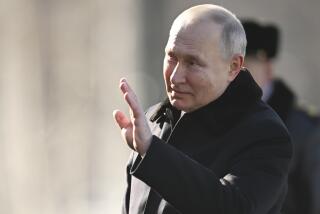U.S., Soviets Agree on Military Liaison Safety
- Share via
WASHINGTON — U.S. and Soviet military officials, after a year of talks since a Soviet sentry killed Maj. Arthur D. Nicholson Jr. in East Germany, have reached agreement on a joint statement and some practical steps that should reduce somewhat the risks of another such incident, Administration officials said Thursday.
The Soviets have steadfastly refused to admit any blame for Nicholson’s death, but the White House has nevertheless directed that its demand for an apology and compensation for his widow and two children be raised repeatedly and forcefully at every diplomatic opportunity, officials told The Times.
The somewhat ambiguous agreement, in the form of an “agreed summary” of the talks that will be formally signed shortly, was reached last month by American and Soviet army commanders in Europe and later approved by the White House.
Both Note Responsibility
In the pact, both nations acknowledge their responsibility for the safety of the military liaison missions attached to each other’s headquarters and promise not to use deadly force against them when they are identified as such. But the document also notes that the duties of a sentry permit him to use force against unidentified intruders.
The United States sought the joint responsibility provision to give added protection to American officers in the future, while the Soviets sought the sentry duty clause to justify their action in the Nicholson case.
During the protracted discussions between U.S. Gen. Glenn Otis and Soviet Gen. Mikhail F. Zaitsev that led to the agreement, the Soviets also agreed to adopt “a number of positive steps,” one official said, including at least one risk-reducing measure used by the U.S. Army on how to identify and treat Soviet officers.
Reporting of Plates
Under this procedure, every sentry will be issued a card that bears the license plate numbers of all authorized vehicles used by the other side and specifies that, if the vehicles are found in forbidden areas, no life-threatening or deadly force should be used to apprehend them. Instead, the license plates are to be reported to superiors.
Defense Secretary Caspar W. Weinberger, who promoted Nicholson posthumously to lieutenant colonel, had demanded an apology and compensation for his family. But the Soviets refused even to discuss those issues.
As a result, Weinberger reportedly approved the Otis-Zaitsev agreement with great reluctance and only after an interagency compromise in which the State Department was directed to repeat the demands, strongly and at every opportunity, through diplomatic channels.
The White House issued a national security directive approving that two-track procedure, sources said.
The Administration nonetheless anticipates criticism from conservative Republicans, who accused the State Department of soft-pedaling the Nicholson incident in seeking a U.S.-Soviet summit meeting. It would have preferred to keep the agreement secret.
No Department Comment
A Pentagon spokesman refused to comment Thursday on the agreement, as did State Department officials.
Nicholson was one of about 14 U.S. Army and Air Force officers assigned to Soviet headquarters in Potsdam, East Germany. An equal number of Soviet officers are attached to U.S. headquarters in Stuttgart, West Germany.
These missions were created after World War II by all four occupying powers--Britain, France, the United States and the Soviet Union--to facilitate cooperation. Since then, they have largely engaged in collecting information on the military activities of their hosts in what has been termed “legalized spying,” similar to the jobs of defense attaches in foreign capitals.
Mission personnel must wear national uniforms and travel in vehicles with identifying license plates, however, and are barred permanently from certain sensitive military areas and, at times, from places where maneuvers are under way.
Temporarily Off-Limits
Nicholson was killed March 24, 1985, in broad daylight near a Soviet training base at Ludwigslust, East Germany. With a U.S. sergeant as his driver, he was operating within these rules in an area that had been designated temporarily off-limits a few months earlier but was no longer restricted, investigations later showed.
A young Soviet sentry spotted Nicholson near a tank shed across the road from the sentry. The U.S. sergeant waited with the vehicle on the road, roughly between Nicholson and the sentry.
Although an order to halt is the standard first warning in such situations, the American sergeant said he did not hear any call by the Soviet sentry before he opened fire. And the first shot, rather than being fired into the air, came close to the sergeant.
Third Shot Fatal
A second shot, which should have been fired at the knees to disable, narrowly missed the sergeant. The third killed Nicholson as he sprinted toward the vehicle for cover.
The bullet, fired from more than 50 yards away, entered his stomach and clipped vital organs, including an artery, and he quickly bled to death. Weinberger and other officials were incensed at the Soviets’ refusal to allow the sergeant to give first aid for Nicholson and at the insensitive way the Soviets conducted proceedings at the scene.
Some Still Vulnerable
The subsequent military talks in Germany, which examined the incident and sought to reduce risks of a recurrence, produced the agreement, which basically provides that a Soviet sentry will not shoot American officers from the liaison mission if he has identified them as such. However, other Americans, or Americans from the mission whom the sentry may fail to identify, still seem vulnerable.
Nonetheless, one U.S. official said, the agreement can be seen as Soviet acknowledgment that a dangerous problem exists and that Moscow will try to solve it. That, the official said, is better than nothing.
More to Read
Sign up for Essential California
The most important California stories and recommendations in your inbox every morning.
You may occasionally receive promotional content from the Los Angeles Times.












